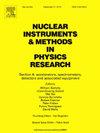Record high counting rate of positron annihilation lifetime spectrometer achieved by β+-γ coincidence
IF 1.5
3区 物理与天体物理
Q3 INSTRUMENTS & INSTRUMENTATION
Nuclear Instruments & Methods in Physics Research Section A-accelerators Spectrometers Detectors and Associated Equipment
Pub Date : 2024-10-28
DOI:10.1016/j.nima.2024.170013
引用次数: 0
Abstract
Conventional positron annihilation lifetime (PAL) spectrometers, which employ the coincidence with two perpendicularly-positioned detectors, have a typical counting rate of 100–300 counts per second (cps). To increase the counting rate, according to the optimized structural parameters using Geant4 simulation, a 22Na positron source ( 1.665 MBq), a silicon photomultiplier (SiPM), and digital waveform technology are utilized for the first time to a coincidence PAL spectrometer. After the optimization and verification of accuracy and stability, this spectrometer can achieve a time resolution of about 206 ps, and a record high effective counting rate of approximately 19 000 cps ( 11 000 cps/MBq), which is two orders of magnitude greater than those of conventional PAL spectrometers. The significant shortening of measurement time for a single PAL spectrum enables us to observe sub-minute-scale evolution of microstructure during rapid physical and chemical processes in the future.
正电子湮没寿命谱仪通过 β+-γ 巧合实现创纪录的高计数率
传统的正电子湮灭寿命(PAL)光谱仪采用γ-γ重合,有两个垂直放置的探测器,其典型计数率为每秒 100-300 计数(cps)。为了提高计数率,根据利用 Geant4 仿真优化的结构参数,首次将 22Na 正电子源(∼ 1.665 MBq)、硅光电倍增管(SiPM)和数字波形技术应用于 β+-γ 重合 PAL 光谱仪。经过对精确度和稳定性的优化和验证,该光谱仪的时间分辨率可达约 206 ps,有效计数率高达约 19 000 cps(约 11 000 cps/MBq),比传统 PAL 光谱仪高出两个数量级。单个 PAL 光谱的测量时间大大缩短,使我们能够在未来观测快速物理和化学过程中微观结构的亚微米尺度演变。
本文章由计算机程序翻译,如有差异,请以英文原文为准。
求助全文
约1分钟内获得全文
求助全文
来源期刊
CiteScore
3.20
自引率
21.40%
发文量
787
审稿时长
1 months
期刊介绍:
Section A of Nuclear Instruments and Methods in Physics Research publishes papers on design, manufacturing and performance of scientific instruments with an emphasis on large scale facilities. This includes the development of particle accelerators, ion sources, beam transport systems and target arrangements as well as the use of secondary phenomena such as synchrotron radiation and free electron lasers. It also includes all types of instrumentation for the detection and spectrometry of radiations from high energy processes and nuclear decays, as well as instrumentation for experiments at nuclear reactors. Specialized electronics for nuclear and other types of spectrometry as well as computerization of measurements and control systems in this area also find their place in the A section.
Theoretical as well as experimental papers are accepted.

 求助内容:
求助内容: 应助结果提醒方式:
应助结果提醒方式:


